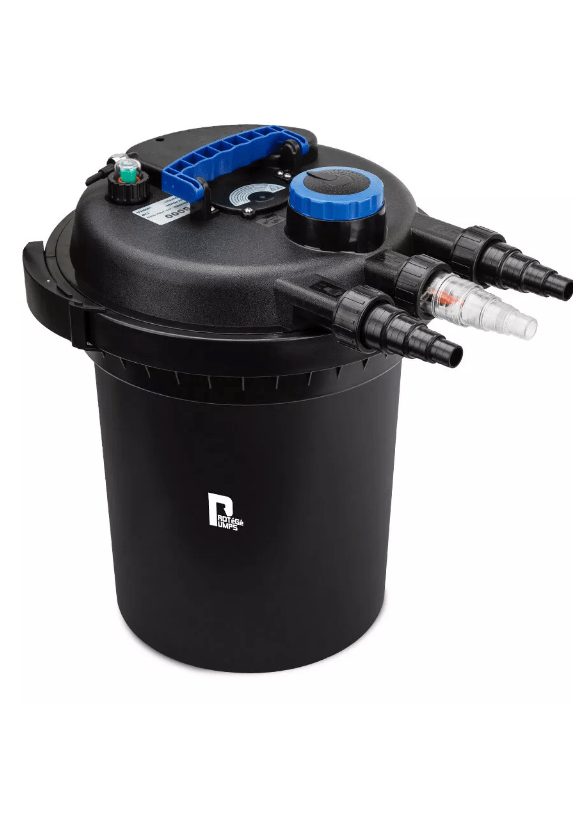The most important aspect of any pond is how you’re going to filter the water. In this article I’ll explore 5 options, some you can buy straight of the shelf and others are a diy project.
Properly filtering your pond will prevent algae blooms and keep the pond safe for fish.
There are 3 ways to filter pond water: Chemically, mechanically and biologically. The most important is biological filtration ( converting harmful compounds naturally) followed by mechanical ( removing solid particles, ie fish poo). In a pond we should be able to avoid the need for chemical filtration provided we get the other two right.
All of the below examples will filter pond water biologically. Some will remove solids (Mechanical filtration) better than others.
Pressure filters
These are probably the most commonly sold pond filter for the backyard pond. The come in varying sizes suitable for small and large ponds. They will need a pond pump capable of supplying the required flow.
Pressure filters work by forcing the water through the filter, hence the name pressure filter. Within the filter will be some kind of media, this may be BioBalls, course sponges or brushes etc..This media will seperate fine solids (mechanical filtration) but more importantly provide a home for good bacteria’s (biological filtration).
These days many pressure filters will incorporate a UV light. A UV light isn’t really a filter but can be a useful item to have in ponds that are prone to single cell algae outbreaks (when the pond goes pea soup green). UV lights will have no impact on stringy algae.
Pros:
- Pressure filters are good in that they are very small and compact, thus easy to conceal.
- They can be partially buried so only the top is visible.
- Generally easy to maintain by backwashing. This is manually pumping water through the filter to dislodge solid build up within the filter.
- Good for ponds with streams and waterfalls.
Cons:
- Not a great choice for fish ponds. The fish produce extra solids (poo) but also produce ammonia that needs ample biological filtration to properly process. Quite often pressure filters just aren’t up to the task.
- Having water under pressure moving outside the pond can be a problem if the filter becomes clogged. A hose popping off could lead to the pump emptying your entire pond.
- Overtime parts of the filter will wear, break and need replacing.
- Needs very regular maintenance and inspections, certainly not a set and forget option.
All in one filters
An all in one filter is a pond pump, filter and sometimes even a UV light all in one. In this situation the filter/pump sits directly inside the pond.
All in one filters work by drawing the water through a filter chamber that contains similar media to a pressure filter. As the water is drawn through the media it is cleaned and returned to the pond.
These filters are best suited to smaller ponds with a simple fountain.
Pros:
- Good beginner option.
- Everything sits within the pond no risk of leaks from exploding hoses.
- You only need one electrical socket. I hate having cords running everywhere!
Cons:
- Will require regular inspections and maintenance.
- Annoying to perform inspections and maintenance as the entire unit needs to be removed from the pond.
- Again not a great option for ponds with lots of fish.
Trickle/ shower/ box filters
Trickle, shower or box filters are similar to pressure filters in that the water is pumped to an external filter, however in this situation the water isn’t under pressure. Generally the water is pumped into the filter and then a spray bar evenly distributes the water over the top of the filter media.
Again the media can be course sponges, filter pads, ceramic noodles, bio balls or a combination of all. As the water cascades through the media it is purified and small solids are removed. The clean water is then returned to the pond by gravity.
Because gravity is used to return the water to the pond these filters must be placed at a higher point than the actual pond. They are also substantially larger than the previous mentioned filters.
Pros:
- Can handle larger fish stocking ratios.
- Energy efficient in that only a pump is required.
- Can be quite easily built yourself.
- Less moving parts = less can go wrong.
Cons:
- Still requires regular inspections and maintenance. Washing out the sponges and pads ect.
- Take up much more room than pressure and all in one filters.
Moving media filters
Moving media filters are another great option for those wishing to keep large numbers of fish. These filters work by passing large amounts of water over, around and through light weight media that houses beneficial bacteria.
Most commonly a type of media known as k1 is used. It’s very light weight, small, yet provides plenty of surface area for the bacteria’s to colonise. The reason for such a light weight media is that as the name suggests this media is in constant motion.
The motion is created either by the velocity of the water entering the filter but more commonly the presence of an air stone. The idea being that this constantly moving water provides a very oxygen rich environment for the bacteria’s to thrive.
Pros:
- Great for large fish like koi or highly stocked ponds
- Really effective biological filter.
- Fairly easy and comparably cheap to build yourself.
Cons:
- Quite big and bulky.
- More moving parts = more could potentially go wrong.
- Provides no real solid removal, ie mechanical filtration.
Bog / wetland filters
Here is the last example and in my opinion easily the best choice for most ponds. A bog or wetland filter is low tech, low maintenance and provides amazing water quality and clarity.
These types of filters work by mimicking the role a wetland or bog plays out in the wider environment. Bogs and wetlands are waterways natural filters. They utilise slow moving water, plants and bacteria’s to turn polluted water into clean healthy water.
A bog or wetland filter works by pumping the water through a constructed wetland or bog. One of the most important parts to this type of filter is slowing the water down as it moves through the bog or wetland.
This provides two very important functions.
- As the water velocity is slowed it allows solids to settle. This is the fish poo, other broken down vegetation to accumulate within the filter. Remember this is mechanical filtration.
- Provides more time for the beneficial bacteria’s growing on the rocks and plant roots within the filter to purify the water.
Because these systems create a harmony or balance between bacteria’s purifying the water but also plants removing nutrients they require very little human intervention. Any of my ponds greater than 100 litres utilise these awesome filters.
You can build them very easily for any sized pond. Check out my article on “how to build a diy pond filter”.
Pros:
- Almost zero maintenance.
- Looks nice as it’s basically just a water garden.
- Can handle large fish loads.
- Very few moving parts not much can go wrong.
- Provides 2 types of filtration (biological and mechanical) but also removes nutrients from the water helping prevent algae.
- Completely natural.
- Provides valuable habitat for insects, bees and amphibians.
- Allows water plants to be kept outside of the pond which provides more open water.
Cons:
- Will increase the overall footprint of the pond. Unless you place the filter directly over the pond like in my wine barrel ponds.
- I can’t think of another one. Like I said these really are terrific!
Hopefully this short article has been helpful. If so consider subscribing to my mailing list and YouTube channel. Have fun playing in your pond!

